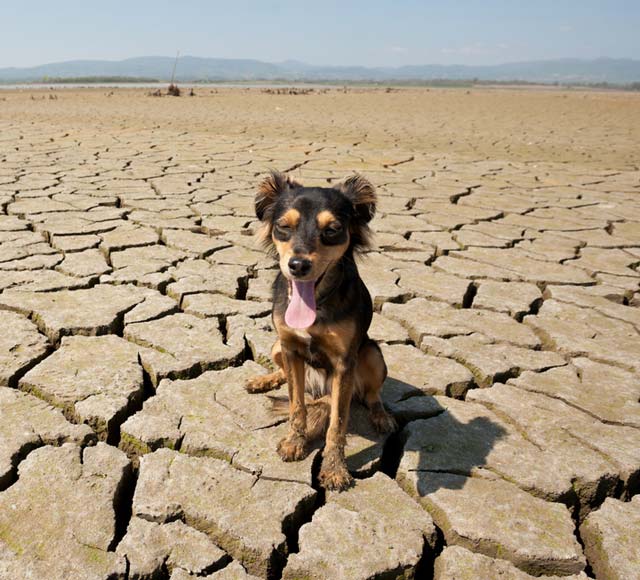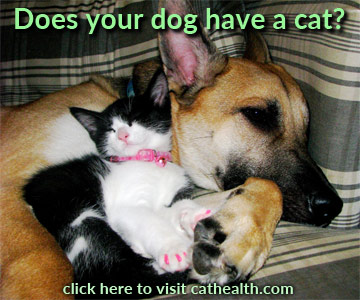Dehydration in Dogs

Dehydration in dogs happens when there is less fluid in the body than it needs to function properly. Dehydration also causes a lack of essential electrolytes in the dog's system. Fluid and electrolytes are essential for circulation, digestion, and waste removal and are the basis of all of the body's tasks. When there is not enough fluid in your dog's body, these functions aren't able to be performed properly, and he can get sick.
What Causes Dehydration in Dogs?
Dehydration can be caused by an increased loss or a decreased intake of fluids.
-
Ways a Dog May Lose Too Many Fluids
- Overheating on a hot day can result in dehydration through fluid loss.
- A bout of vomiting and/or diarrhea causes a loss of fluids in the body.
- A metabolic disorder such as diabetes mellitus or kidney disease can cause increased fluid loss.
- A fever can result in dehydration.
- Blood loss may cause a dog to lose fluids quickly.
-
Reasons a Dog May Not Take in Enough Fluids
- Dogs that are ill may not take in enough water because they feel nauseous or too sick to move around.
- Dogs that are lost may not be able to find an adequate water source.
- Dogs that are left outdoors without fresh, unfrozen water can quickly become dehydrated.
- Indoor dogs that aren't left with enough water while owners are away or with water in bowls that tip over easily can be chronically dehydrated.
Why Is It Important to Know If Your Dog Is Dehydrated?
Dehydration causes your dog to feel lethargic. He may not want to move around or go to his water bowl to drink. In this way, dehydration from any cause can start a vicious cycle that leads to further dehydration. If it is left untreated long enough, dehydration will cause organ failure and death. If your dog is dehydrated because of an underlying illness, it is important to have it diagnosed and treated before it gets worse.
How to Tell If Your Dog Is Dehydrated
- Look at his eyes: If your dog's eyes appear dull and sunken into the sockets, he is probably dehydrated.
- Do a skin tent test: The skin of a dog that is well-hydrated has elasticity. When you pull it up away from the dog's body and then let it drop, it will bounce back to its original position quickly and completely. A dog that is dehydrated loses some skin elasticity. When you gently pick up a piece of his skin between your thumb and first two fingers, then drop it, watch to see how quickly it bounces back. This test can be a little tricky to interpret and relies on you knowing what the normal skin response looks like, so don't trust it entirely. If your dog is showing any other signs of dehydration or you suspect it for any reason, visit your veterinarian.
-
Look at his mouth:
- Your dog's gums should be pink and glistening. If they appear dry and feel tacky when you touch them, your dog is dehydrated.
-
When you push lightly on your dog's gums, a blanched area will appear. When you let go, the lighter area should return to its normal pink color within two seconds. If it takes longer, your dog may be dehydrated.
- Your dog's saliva should be thin and mostly unnoticeable. If it looks thick and ropey, dehydration may be present.
- Animals that are sick may not accept handling as well. Take care when looking in your dog's mouth, and stop if he acts upset.
These signs of dehydration are more non-specific and may be present when dehydration is not:
- Lethargy
- Lack of appetite
- Increased heart rate
Treatment of Dehydration in Dogs
The first goal in the treatment of dehydration in dogs is fluid replacement. If the dog is not vomiting and has no underlying condition that is complicating the dehydration issue, fluid replacement can be accomplished orally. Giving small amounts of fluid often until the dehydration is resolved is the best way to accomplish this.
If your dog won't accept oral fluids or can't keep them down because of vomiting, they will have to be replaced parenterally. This means that the fluids will need to be given in a way other than through the GI tract. The two most common ways of accomplishing this are:
- Subcutaneously: This method of delivering fluids deposits them underneath the skin through a needle. They are then absorbed into the dog's system over the next few hours. This may not be enough if the dog is severely dehydrated or if he is not able to drink and keep down the fluids necessary to maintain his hydration after the subcutaneous fluids have been used up by his body.
- Intravenously: Dogs can be given fluids intravenously through a catheter that is placed into a vein. This is usually done while the dog is hospitalized in a veterinary clinic.
The second goal in the treatment of dehydration in dogs is reversing or treating the underlying cause. If the cause was overheating or increased exercise, the treatment may be simply ensuring that your pet always has access to enough fresh, clean water. If a bout of vomiting caused the issue, your veterinarian may treat your dog with medications.
If an underlying, chronic condition such as kidney disease caused the problem, your dog will be at risk for consistent dehydration unless the disease is managed. There are specific treatments for each of these conditions, so it is important to have it properly diagnosed.
Preventing Dehydration in Dogs

- Provide plenty of fresh, clean water. Change the water in your dog's bowl several times a day so it is always clean and new. Remember to wash your dog's water bowl once a day to prevent bacterial growth.
- Pay attention to your dog's water consumption. In general, a dog requires about 1 ounce of water per pound of his body weight per day. If your dog is drinking much less than that, or much more, see your veterinarian right away. Remember, just because your dog is drinking lots of water doesn't mean he can't be suffering from dehydration if he has an illness that impacts the way his body uses the fluid (such as kidney disease).
- If you are often away from home, get a weighted water bowl. These types of bowls are heavy on the bottom so they can't be tipped over. This is also important for dogs that spend time outside.
- While playing outside or hiking with your dog, bring a portable water source. Remember that your dog will need to replenish his fluids if he is exercising, and a water source may not be readily available while you are out and about. Your dog needs water while exercising in cold weather as well as when it is hot. There are light, easy traveling water solutions for hiking and playing with your dog.
- If you absolutely must leave your dog outdoors alone, provide fresh water in an un-tippable bowl. Your dog must have access to fresh, unfrozen water at all times. Leaving him tied up outside is dangerous because many things could happen that would keep him from having this access; he may become tangled and not be able to reach his water or it could get spilled, dirty, or frozen. Your dog must also be provided with shelter from the sun, wind, and cold if he is outdoors alone.
- If your dog has a bout of vomiting: Don't allow your dog free access to unlimited water soon after vomiting. Dogs sometimes drink too much at once in this case, triggering more vomiting and leading to even more dehydration than they would have otherwise experienced. Provide your dog with small amounts of water often for the first few hours after a vomiting episode. If the vomiting continues, see your veterinarian.
Dehydration can be serious in dogs. It may indicate a life-threatening underlying condition. Simple cases may lead to much greater illness quickly. Knowing the signs of dehydration and seeing your veterinarian immediately can prevent bigger problems.
You May Also Like These Articles:
Giving Your Dog Clean and Fresh Water
How to Be Prepared for Your Dog's Veterinary Bills
Disclaimer: This website is not intended to replace professional consultation, diagnosis, or treatment by a licensed veterinarian. If you require any veterinary related advice, contact your veterinarian promptly. Information at DogHealth.com is exclusively of a general reference nature. Do not disregard veterinary advice or delay treatment as a result of accessing information at this site. Just Answer is an external service not affiliated with DogHealth.com.
Notice: Ask-a-Vet is an affiliated service for those who wish to speak with a veterinary professional about their pet's specific condition. Initially, a bot will ask questions to determine the general nature of your concern. Then, you will be transferred to a human. There is a charge for the service if you choose to connect to a veterinarian. Ask-a-Vet is not manned by the staff or owners of DogHealth.com, and the advice given should not delay or replace a visit to your veterinarian.



